The Best Guide to Visiting Lyon
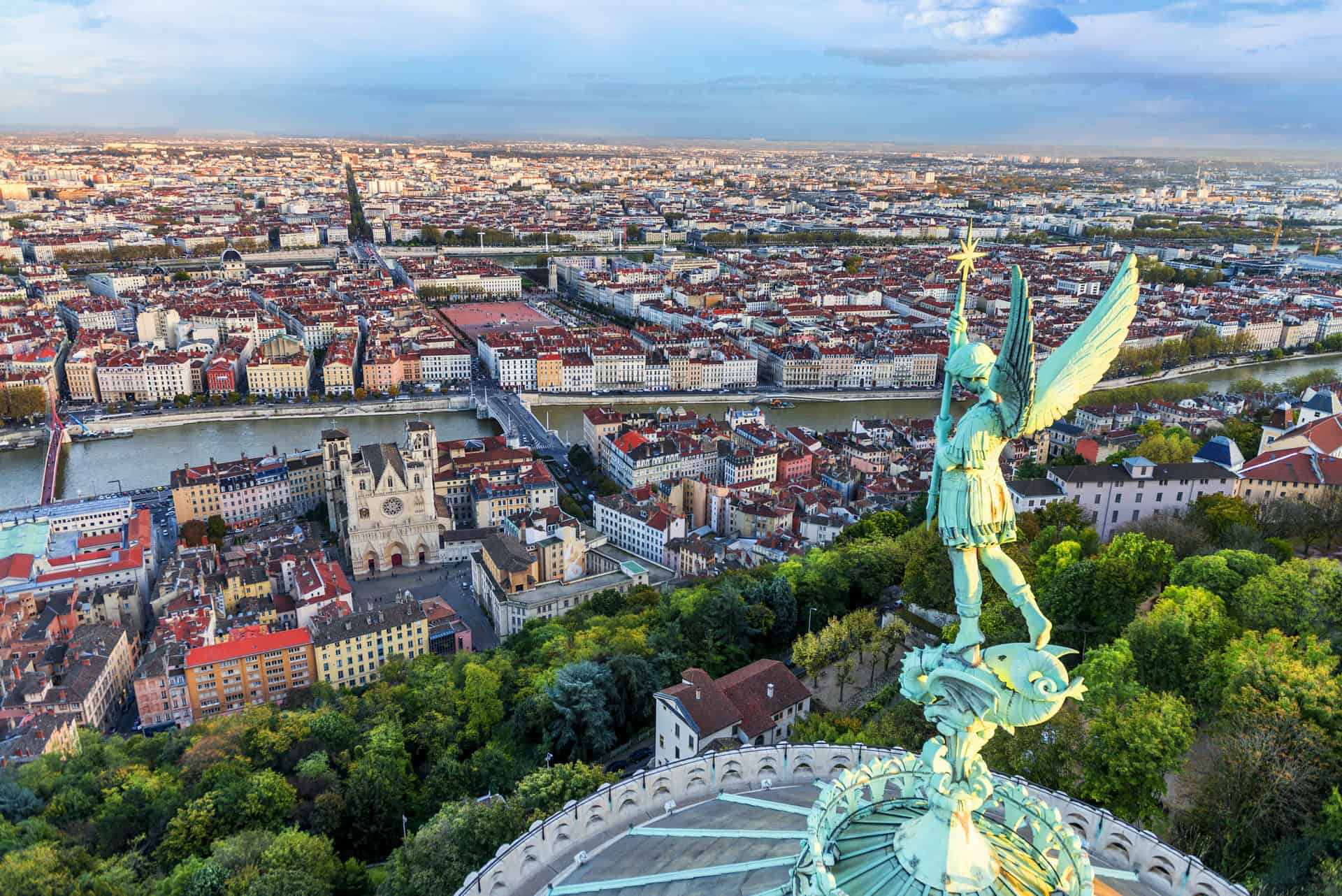
Updated On: November 08, 2023 by Ciaran Connolly
Lyon, the third biggest city in France, is definitely worth visiting. It is the city of beautiful contradictions. Lyon has a sensational mix between the charm of smaller towns and the excitement of big cities. So, whether you are a country lover or a city mouse, visiting Lyon should be on your bucket list.
Lyon is the city where you cannot get bored. The city is overflowing with activities to do and things to see. From historical monuments to modern art museums and amazing food, there will be no dull moments when visiting Lyon.
The 2000 year-old city has a glamour that is yet to be discovered by tourists. Even though it is one of the biggest cities in France, Lyon is not that famous amongst travelers (yet). This has granted the city’s visitors a perk like no other; the Lyonnais attractions are not as crowded as their counterparts elsewhere.
The Ultimate Guide to Visiting Lyon
The charm of Lyons cannot be attributed to only one aspect. It is full of historical sites and museums. Most important of all, Lyon is the world’s gastronomic capital for its exquisite cuisine. While having many attractions is a great advantage, it might be confusing for you as a tourist. Here’s the list you need to prepare your itinerary for visiting Lyon:
- The Museum of Fine Art
- Vieux Lyon
- Traboules
- Parc de la Tête d’Or
- The Gallo-Roman Museum
- Institut Lumière
- Croix-Rousse
- The Roman Theatre
- The Basilica of Notre-Dame de Fourvière
If you’d like to know about the history of Lyon, check our detailed article here.
The Museum of Fine Art (Musée des Beaux Arts)
Having 70 rooms, the Museum of Fine Art (Musee des Beaux Arts) has the largest art collection in France. It was founded in 1803. The cornerstone of the museum was laid when the Louvre Museum donated 110 paintings. Since then, the Museum of Fine Art has grown to be the second most important museum in France, right after the Louvre.
The Museum of Fine Art is situated in a 17th-century palace in Lyon. The palace was originally built for the Royal Abbess of the Dames de Saint Pierre. It was then remodeled by Louis XIV. So even if you are not into art, you should visit the museum to look at its architectural brilliance.
The museum houses great art pieces from different eras. It displays more than 600 Ancient Egyptian pieces. Other masterpieces at the museum include statues, art works, ceramics, and paintings. There are 35 rooms in the museum that are dedicated to European paintings, from classic artists such as El Greco and Rembrandt to more modern masters such as Picasso and Renoir.
Visiting Lyon without stopping at the Museum of Fine Art is an incomplete trip. The museum opens Tuesday to Sunday from 9:00 am to 5:00 pm. To get in, you will pay an entry fee of $15 if you are between the ages of 18 and 30. If you are above the age of 30, the entry fee is $25. However, on Wednesday, the museum is open for extra hours from 5:00 pm to 9:00 pm for an entry fee at half the price. Next time you are visiting Lyon, make sure to check this outstanding museum.
Vieux Lyon
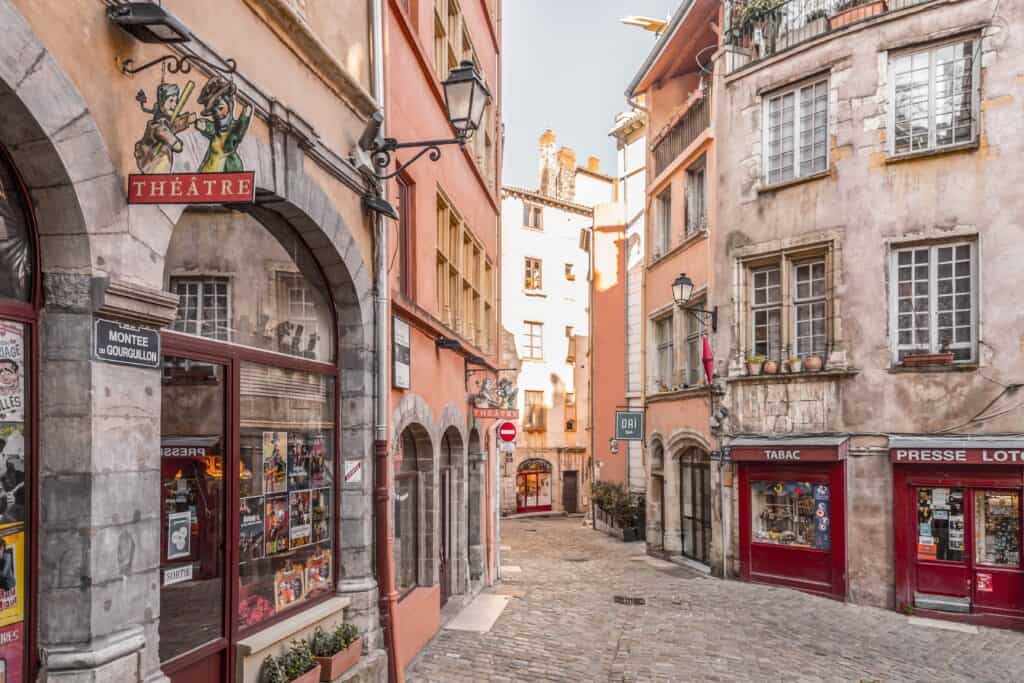
While you are visiting Lyon, pay a visit to its past. Vieux Lyon, literally means Old Lyon, is an old renaissance district. The district’s vibes take you back in time to experience 14th-century France.
Vieux Lyon comprises 300 houses that were built from the 14th to the 17th centuries. During that time, the silk industry was flourishing, so rich merchants built extravagant houses in the gothic, Italian renaissance and French renaissance styles.
The district was planned to be demolished in 1962, but was saved by the Minister of Culture back then. He designated Vieux Lyon a protected area. Luckily, decades later, the district was announced a UNESCO World Heritage site. Nowadays, the district, standing strong, is a time machine in the middle of a modern day city.
Any itinerary you plan for visiting Lyon, must include Old Lyon. Vieux Lyon is open 24/7 for all visitors. You can enter the district for free any time you want. If you have a Lyon city pass, you could get a free guided tour of Vieux Lyon. There are many attractions and sites to be visited in the district. You can check these sites from here! Allow yourself two hours to half a day to enjoy the district thoroughly.
Traboules
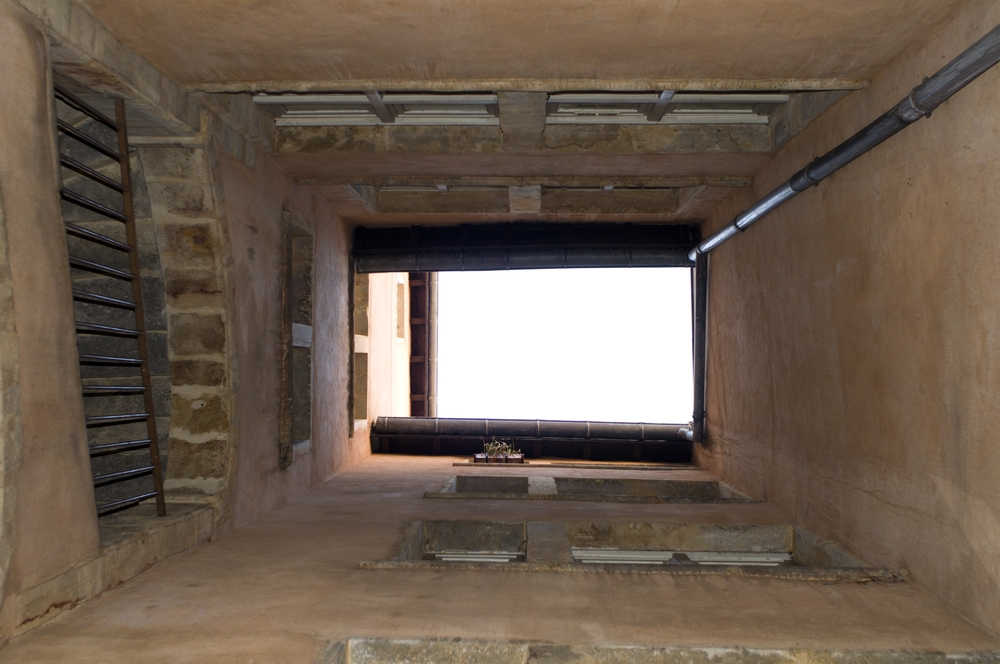
While you are in Lieux Lyon, Lyon’s most unique architectural feature is Traboules. These are secret tunnels that connect the district’s streets and courtyards. The Traboules were constructed in the 4th century so merchants could travel across the city without being seen. This gave merchants a quick and easy way to transport textile around the city.
These historical Traboules were then used by France’s resistance during WWII. Nowadays, the passages stand as a witness on Lyon’s eventful history. Visiting Lyon’s Traboules gives you a feeling of what those events were like.
Hundreds of Traboules exist in the district but only around 40 of them are open to the public. You can either hunt Traboules yourself, or get a tour guide to walk you through them.
The passageways can be found by entering the large doors located between local businesses. They will transfer you to a different world. The Traboules are an escape from the busy life of the city to absolute tranquility.
When visiting Lyon, and during your trip to Vieux Lyon, go on a hunt for the Traboules. Get a first hand experience of French history and give yourself a needed break from the hustle of big cities. It is an experience not to be missed.
Parc de la Tête d’Or
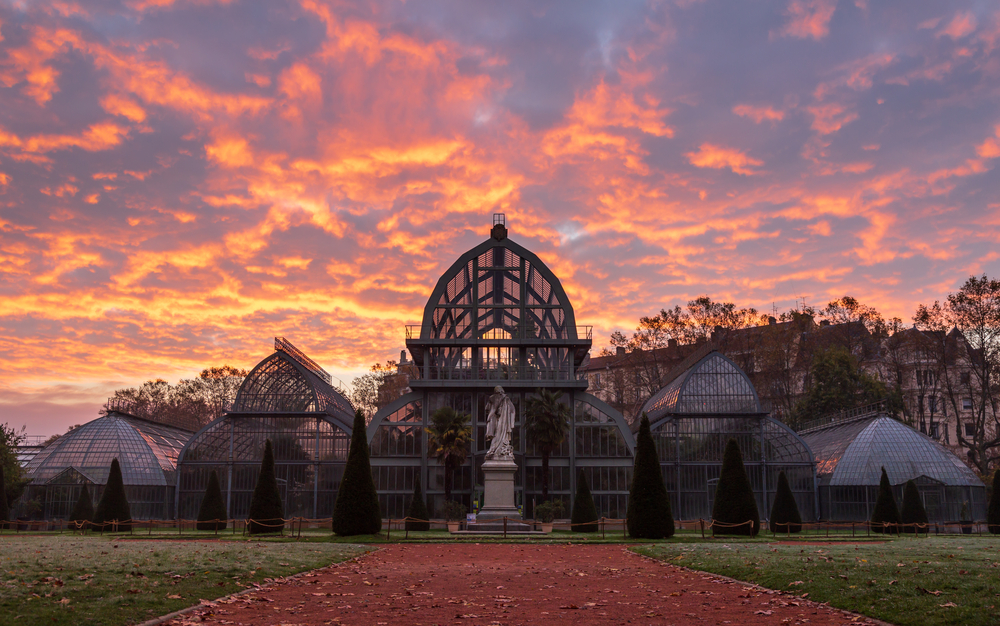
Visiting Lyon on a sunny day? Le Parc de la Tete d’Or is your perfect destination!
Le Parc de la Tete d’Or means the park of the Golden Head. Confused by the name of this park? Here’s a tale to feed your curiosity!
Legend has it that a treasure with the “head of Christ” is buried somewhere in the park. We cannot confirm the validity of the legend. However, this is where the name of the park originates from.
Le Parc de la Tete d’Or was originally created in 1857 by the brothers Denis and Eugène Buhler. The park has embraced many additions since then. These include impressive glass houses that contain plants and flowers from all over the world and a rose garden that features 30,000 rose bushes.
Nowadays, the park stands over 289 acre which makes it the largest urban park in the whole of France. If you are visiting Lyon alone or with family, Le Parc de la Tete d’Or is a great attraction for everyone on the trip. From the beautiful botanic gardens to the fun pony rides, everyone can enjoy this lovely place. Visiting Lyon would never be complete without going to its biggest park, Le Parc de la Tete d’Or.
Other attractions in the park include the African plain, a zoological area of more than 7 acres where different wild animals roam freely. And for all exercise enthusiasts, the park has dozens of trails for walking, jogging and cycling. Quad pedals are also available at the lake for the visitors to pedal while enjoying a relaxing view. Visitors can also swim at the lake.
However, if you are not big on physical activities, the park has spacious places for relaxing or just laying down on the grass. Even though the park has amazing attractions and activities, it has no entry fees.
The opening hours of Le Parc de la Tete d’Or vary according to the month. From 15th April to 14th October, the park is open daily from 6:30 am to 10:30 pm. During winter, however, the opening hours are from 6:30 am to 8:30 pm.
The Gallo-Roman Museum
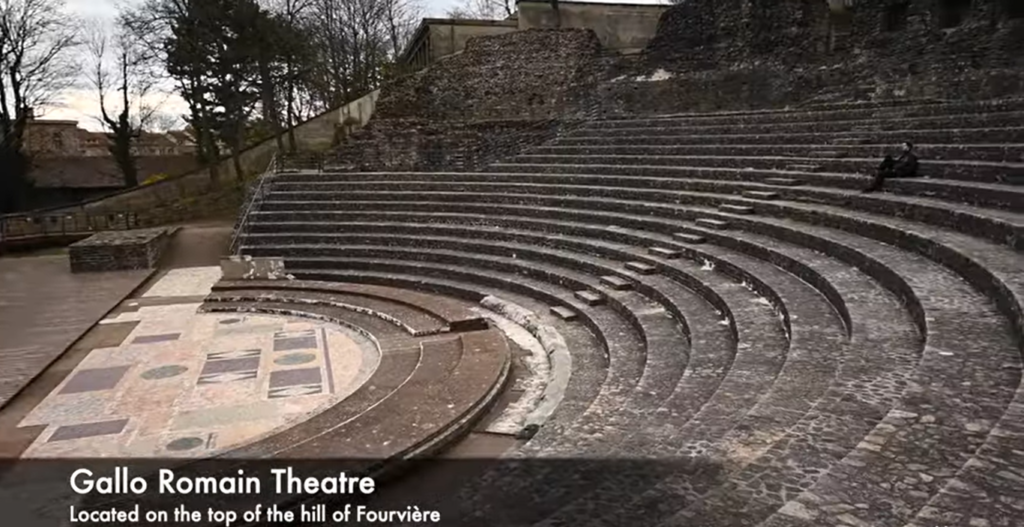
Founded in 43 BC, the Gallo-Roman Museum is an archeological museum that is built at the most appropriate location ever, underground! The museum stands on the site of the ancient Roman city of Lugdunum. It is constructed into the side of Fourvière hill. The idea of the unique construction comes to preserve the archeological site above the hill.
As its name suggests, this museum displays Gallo-Roman era objects. These include vases, gravestones, mosaics, statues, coins, and ceramics. The artifacts displayed at the museum are from digs and explorations carried out in the city of Lugdunum, the archeological sites of Saint-Romain-en-Gal, and Vienne.
Once you enter the museum, you will descend a concrete staircase. Then, you will be able to discover the great monuments exhibited in this breathtaking museum. The museum is overflooded with artifacts, however, one piece not to miss is the Circus Games Mosaic. This masterpiece dates back to the 2nd century BC. It depicts a chariot race with astonishing skills.
Gallo-Roman Museum must be included in any itinerary for visiting Lyon. In addition to its interestingly fitting location, the museum’s building is a beauty in itself. It includes different bunker-like galleries that are arranged around the spiraling concrete ramp.
The museum is open for all visitors six days a week, from Tuesday to Sunday. You can visit any time between 11:00 am and 6:00 pm. The tickets are so affordable; they are only for €4 ($4.63) per person. Children under 18 and disabled persons can visit for free. The museum also has a free entry every Thursday.
Institut Lumière
This attraction is mainly for movie buffs! Institut Lumière is a French organization located in Lyon. It was established in 1982 to commemorate the efforts of the Lumière brothers in creating the cinema as we know it today.
The two brothers, Auguste and Louis Lumière, established the first cinematography of the world in 1895. This sparked the beginning of the film. Before the Lumière brothers, people watched films through individual viewing machines.
The institute is located at the family home where the Lumière brothers created their first moving picture. The home is the location where the popular shot of the employees leaving the Lumière Factory is recorded. This shot is considered by film historians as the first real film ever.
Institut Lumière comprises a museum that is dedicated to the early history of cinema. It also presents daily film screenings. The prominent Institut Lumière holds the annual Lumière Film Festival every October.
The institute is the home where more than a thousand movies were made by the Lumière brothers. A visit to the Lumière Institute would give you great insights into the history of films. You can see many of the original movies and brilliant creations that changed the movie entertainment forever.
For any moviegoer, a stop at the Lumière Institute is a must while visiting Lyon. You can visit the institute from Tuesday to Sunday from 10:00 am to 6:30 pm. However, it is closed on the dates of 25 December, 1 January, and 1 May. An entry fee of €8 ($9.27) is collected to visit the attraction.
Croix-Rousse
Right above Vieux Lyon is situated Croix-Rousse, a bohemian district that is located on one of the hills of the city. This district was the heart of Lyon’s silk industry in the 18th century. Many silk workers had their houses in the neighborhood, earning it the nickname of “the hill that works”.
Tall windows and high ceilings are among the distinctive characteristics of Croix-Rousse’s houses. Silk workers designed their homes in this unique style so they could fit the large looms inside. So make sure to take notice of these hybrid factory homes when you visit the district of Croix-Rousse.
Given the district’s rich history, Croix-Rousse must be a part of your trip when visiting Lyon. However, the visit would never be complete without pampering your wardrobe with one or two silk pieces. Also, do not forget to check the traboules; the passageways that were used by silk-workers to move around the district and to the river bank easily.
The most notable traboule is Traboule Thiaffait. This passage has been restored by the French government. Nowadays, it is lined with artist’s galleries, crafts workshops and fashion boutiques.
The district engulfs many sights and sites that are worth mentioning. These include Marche de la Croix-Rousse (Croix-Rousse market). It is a food market that is held everyday except for Monday. Around a hundred locals gather daily from 6:00 am to 1:00 pm to sell fresh fruit, vegetables, meat, poultry and other products to visitors.
There are also many vendors that sell hot meals, so you can enjoy the taste of authentic Lyonnaise dishes while shopping or people watching. Most of the vendors live in the area which gives you a genuine glimpse of the local life. Try to plan an afternoon for checking this vibrant market and trying the tasty food prepared by the Lyonnaise vendors.
This neighborhood can be said to contain everything. First, an amazing view; the location of the district gives it a panoramic view of the whole city. Second, the district has a number of galleries and museums. These include: La Maison des Canuts museum, the Silk Museum, Fresque “le poisson blue”, and others. Third, the district has many historical sites, such as the Roman Amphitheatre of the Three Gauls ruins, Gros Caillou, and the Traboules around the city.
Finally, the district is full of different cafes and restaurants that would make your stroll around the district more pleasant. The district offers even more for its visitors. Here’s a full guide for a thorough district visit.
The Roman Theatre
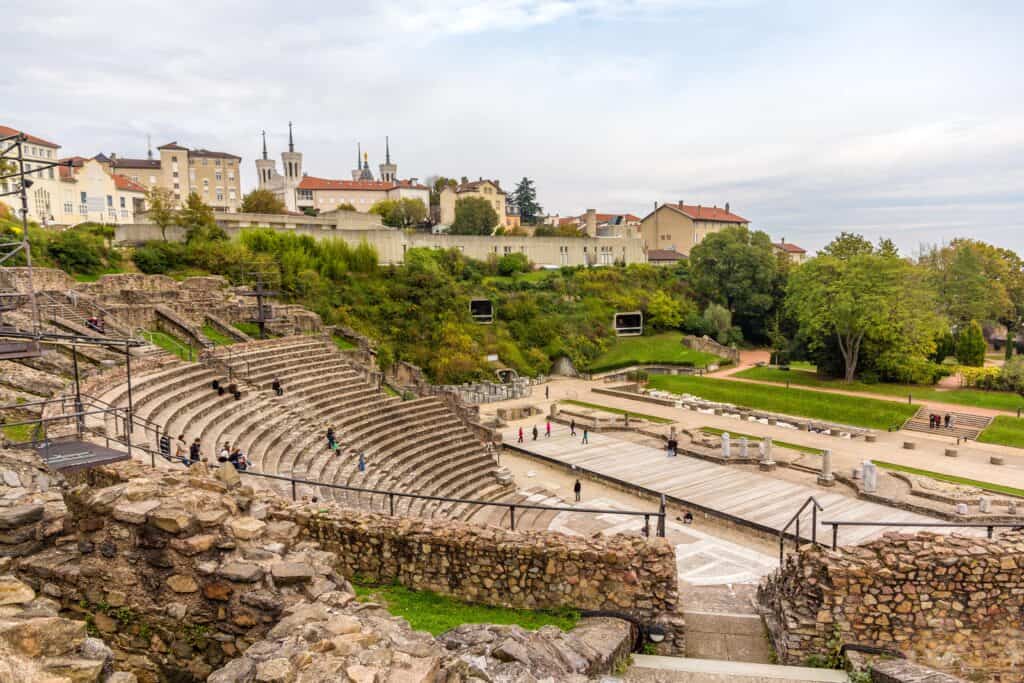
While most cities would have one Roman Theater, Lyon has the privilege of comprising two ancient Roman Theaters! Visiting Lyon would give you the chance to see these theatres in real life.
Both of the theatres are well preserved and located on the Fourvière hill near Lyon’s Basilica. Built in 15 BC, the site includes a theatre, a smaller theatre, and a temple. Historians believe that the larger theatre was dedicated to comedies and tragedies. However, the smaller one was used for political and philosophical orators.
Nowadays, the Grand Theatre is a UNESCO World Heritage site. The theatre was restored in the 20th century and is now used for popular cultural events. One of the popular events held at the theatre is the summertime Nuits de Fourvière festival.
The festival features dance, opera, and circus performers that play alongside international music acts. So, if you are visiting Lyon during summer, specifically June or July, make sure to pay a visit to this marvelous event.
Nowadays, more than 2,000 years after its construction, the theatre is still visited by many annually. You can visit the site daily from 7:00 am to 7:00 pm. There are no entry fees required to get into the site. The place is huge, it can hold more than 10,000 visitors.
The Basilica of Notre-Dame de Fourvière
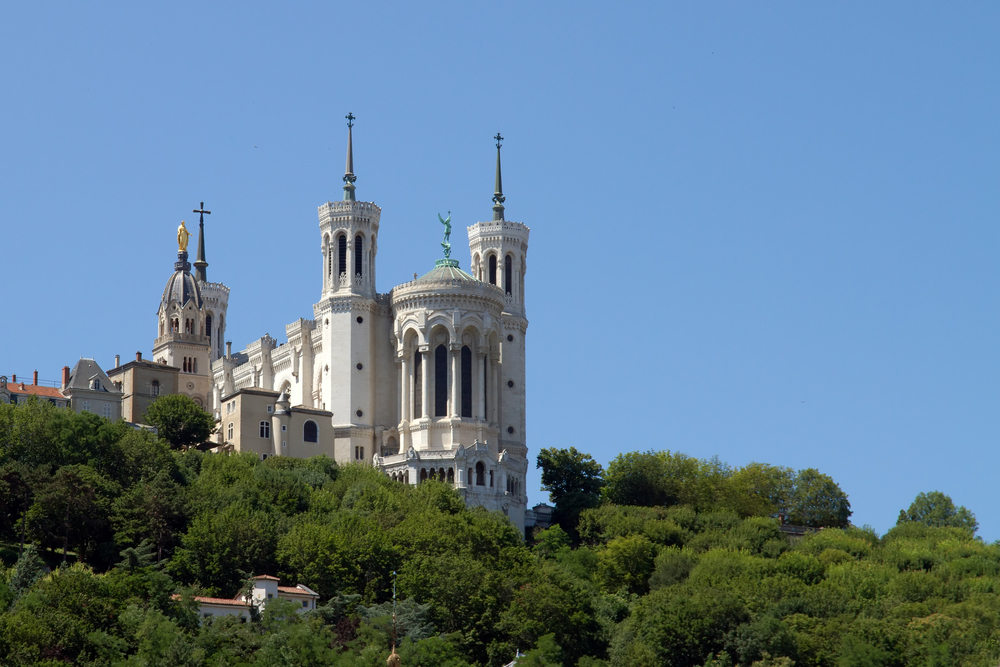
We saved the best for last, the Basilica of Notre Dame! Even though the Basilica of Notre-Dame de Fourvière was built in the late 19th century, it has become the symbol of Lyon. Being located on the city’s tallest hill, this fascinating edifice can be seen from almost anywhere when visiting Lyon.
During the Franco-Prussian war, the people of Lyon vowed to build a basilica if their town was spared. So after the war, the Basilica of Notre-Dame de Fourvière was built to honor the Virgin Mary for protecting their city. It is situated in the west of Lyon. The Church has extravagant interiors; it is decorated with lavish amounts of tinted glass and mosaic. The site also encompasses the Museum of Sacred Art.
Its neo-Byzantine style demonstrates the wealth of the city. The building has a unique architecture. It has a rounded body and four main towers on top. Locals think that the building resembles a bottom-up animal, specifically an elephant. So, it is not surprising to know that Lyonnaises call the basilica the “upside-down elephant”.
You can visit the basilica any day between 8:00 am and 6:45 pm. The admission to the Basilica of Notre-Dame de Fourvière is free of charge. While you are there, make sure to climb the northeast tower to take in the sensational views of Lyon’s cityscape and surrounding areas.
Visiting Lyon is a trip to be remembered forever. There are many things to do and see in the city. The sites and activities can easily fill a three-day itinerary. Just use our guide for visiting Lyon and we are sure you will be able to plan an unforgettable trip.






